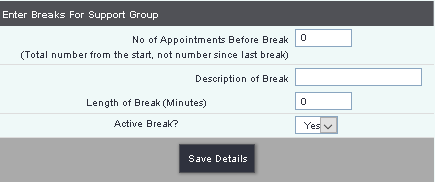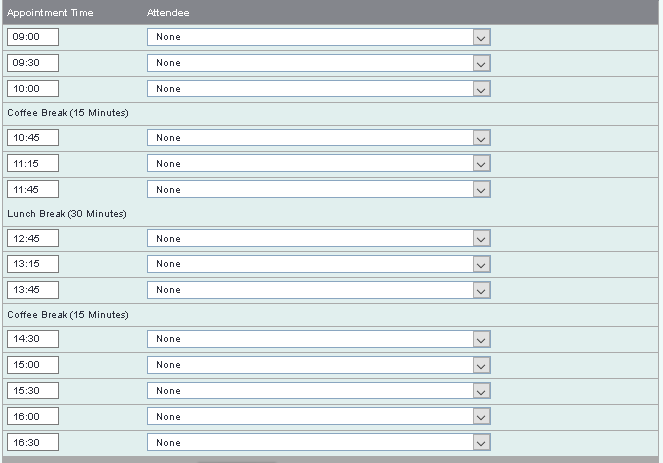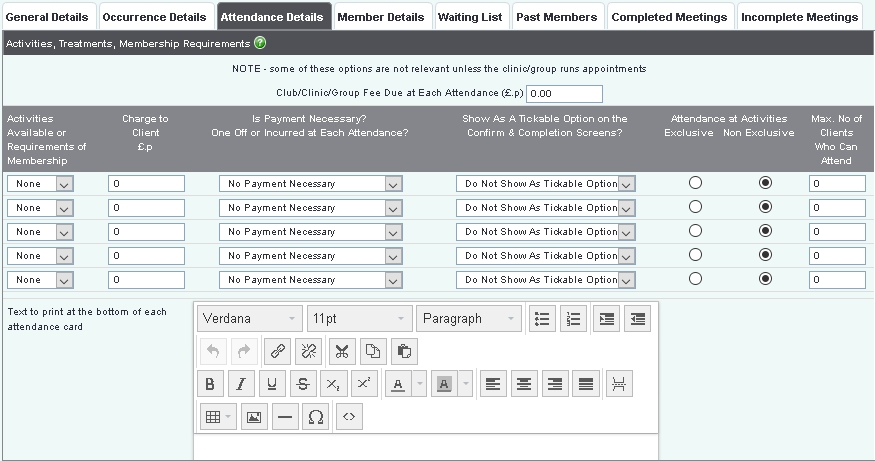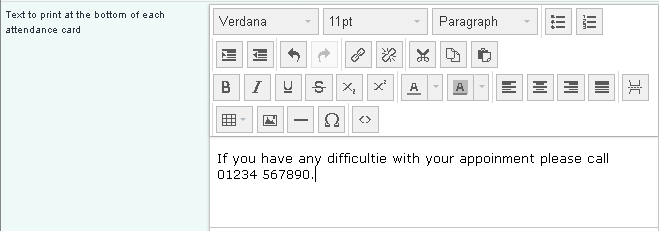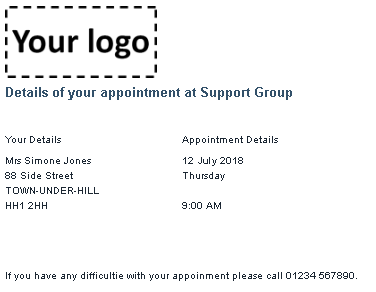Clubs, Clinics & Groups
General Details
The General Details tab holds basic information about a club or clinic.
Fields available are:
Mandatory fields
- Club/Clinic Name
- Project – the Project that this club/clinic is associated with. (When you report on clubs & clinics, you can select one or more projects for the report.) Note that if the Project is made inactive, Clubs and Clinics associated with it will still behave as normal, but when you come to run reports you will probably find that you can't filter by that report if it's inactive.
Optional fields
- Address – the location of meetings.
- Notes – this box is for general information, and isn't output on any report.
- Telephone number – a contact number for the meeting, usually the number of a co-ordinator.
- Cancellation telephone number – a number for people to ring to cancel.
- Fax number, email address – details for the meeting.
- Usual staff/volunteer – if appropriate, the person who runs the meetings.
- Still Active? – Whether this club/clinic is active. Unless you have good reason, don't change this to "No"; it will exclude the group and its data from some reports. Use "Date of Termination" below instead.
- Date of Termination – If the meetings have stopped, the date that this happened. Once this date is passed, the club/clinic won't appear on the main list of clubs/clinics, but will still appear in historical reports.
Occurrences Tab
The Occurrence Details tab holds information about the way meetings happen for this club/clinic. The combination of options you select on this tab will govern whether this meeting is to behave as a Club (where everyone attends at the same time) or a Clinic (where people attend in timed appointment slots).
Information fields
- Day Event Usually Occurs, Interval Between Events and Number of Days/Weeks Between Occurrences – these three fields tell the system how often the meetings are going to happen. Set as appropriate for your meeting. For example, if a clinic occurs every week, select 'Weeks' and put '1' into the Interval Between Events. If it occurs every 2 months, select 'Months' and put '2' into the Interval between Events.
- Bring Forward Client Appointments – this field controls whether the system will assume that because someone attended the last meeting, they will be planning to attend the next one, and automatically carry them forward to the next meeting.
- Gap Between Client Attendance - This represents the interval between each attendance by the client. The club or clinic may occur every week, but the client only presents themselves every 8 weeks - in this case the Interval would be 8, being the gap between their attendances at the clinic or club. If they come every time the event occurs, enter a '1'.
- Maximum Number of Members – this is the maximum number of people that can be on the membership list. If a user tries to add more people than this setting allows, the system will prevent them and explain why with a popup message.
- Maximum number of attendees – this is the maximum number of people that can attend one occurrence of the club or clinic (note that the maximum number of members might be much higher than the maximum number of attendees).
- Save Completed Attendances into Client History? – if set to “yes’”, the system will automatically insert a contact on the client’s History tab after they attend a meeting.
- Contact Method to use in History for Attendances – the contact method to be used on these automatically-created contacts. (taken from the drop-down list of contact methods set up on your system)
- Contact Method to use in History for Non-attendances – the contact method to use if the client is due to attend, but does not.
- Start and end times – the times that the club/meeting/session begins and ends.
- How long for each appointment? – this is only relevant when running Clinics (where the people attend in timed slots). If set to anything except 0, timeslots will be created. (For example, if the start time is 1200, end time is 1400, and you enter 20 here, the system will create six 20 minute timeslots.)
- Record how long the client spends there? – this can be used to manually enter how long the client has been at a meeting for. This is for reporting use. Data is entered on the Enter Actual Attendances page.
- Allow Entry Of Anonymous Attendees? - Governs whether you can record anonymous people - people who have attended a session but are not clients on your Charitylog system. Data is entered on the Enter Actual Attendances page.
- Allow Entry Of Notes In Completion? – Governs whether or not you can edit someone's Notes from the Membership Details page on completion of an occurrence). Data is entered on the Enter Actual Attendances page. Note that you always edit the same text field with this feature, you don't add a new field after every meeting.
- Allow Entry of Non-Attendance Reasons? – Governs whether you can enter non-attendance reasons (on completion of an occurrence).
- Hide Payment Column/Donation Column In Non-Wizard Attendance Entry? – these options allow you to remove the columns for payments and donations when you fill in whether people attended or not. You might choose to do this because you want to make the data entry screen simpler (if you don’t need this data). Data is entered on the Enter Actual Attendances page.
- Record All Cancellations (Time Of Cancellation And Reason)? – setting this to “yes” will prompt users to enter one of the non-attendance reasons when removing a client from the attendance list of a future meeting. See Enter Cancellation Information for full details.
Breaks in the session
If you are running a Clinic, where timeslots for attendance are being used, you may want to insert breaks in the day. For example, you might run an all-day drop in from 0900 to 1600, in hour timeslots, but want to add a lunch break for whoever's running the session. Without a break, the timeslots for the day would look like this:
However, this break can be inserted so it shows on the booking screen and also the paperwork. On the "Occurrence Details" tab, click the "Enter New Break" button.
You can now enter:
- the number of timeslots that come before the break. In this example, the timeslots are an hour long, and the session starts at 0900; so if we want to put the lunch break at 1200-1300, you need to enter 3 here as there are 3 sessions that will happen before the break (0900-1000, 1000-1100, and 1100-1200).
- description of break
- length of the break in minutes
- whether this break is active or not
Then click "Save Details".
Now, the timeslots for the day look like this:
The 1200-1300 slot is now assigned as a lunch break, and attendees cannot be booked for it.
Attendance Details tab
Location in standard build: Clubs and Clinics > Clubs/Clinics/Groups > Click on club/clinic in question > Click on "Attendance Details" tab
The Attendance Details tab (displayed on the Club & Clinic Details page) lets you set various options about things that happen each time someone attends this club/clinic. The way that you set the options depends on how complicated the meetings in question are.
Club/Clinic/Group Fee Due at Each Attendance
This field lets you enter a fee which clients pay to attend. This will be displayed on the Completion screen (where users enter details of who attended a session), with the option to say whether the client paid or not.
Note: this charge is nothing to do with the Invoicing module. If you're using the Invoicing module, the charging is entirely driven by the Charge Rate set on the client's Membership Details page.
Activities, Treatments and Requirements of Membership
Available Activities etc are set up on the Treatments And Activities page.
This section is multi purpose; it can be used to enter details of things that may happen at the session, items the client may purchase while they are there, treatments the client may receive, and so on. For example -
- If the session has several activities available (e.g. an art class with painting, drawing, ceramics and knitting), these would be set up here.
- If there are refreshments available which the client can choose to have at the session, these would be set up in this section - "cup of tea", "lunch" etc.
- If there is a form that the client needs to fill in when they attend, this could be set up here too.
Each line in this section can have an associated cost, the option to show it as a tickable option when entering client attendances, whether the activity is exclusive or not, and a maximum number of clients who can take this option when they attend.
Note: as with the change for attendance above, the charges you set for Activities are not linked to the Invoicing module. If you're using the Invoicing module, the charging is entirely driven by the Charge Rate set on the client's Member Details page.
Text to print at the bottom of each attendance card
Text you set here will be printed on each Appointment Card.
This will print on each appointment card as shown:
Member Details tab
The Member Details tab shows all the people that are Members of this club/clinic. Remember that Members are all the people who might attend; if someone is on this tab it doesn't necessarily commit them to attending at any point, it just means that they can be booked to attend an occurrence if desired.
By clicking the headings here, you can re-order the list of members.
The list displays the following information about the members:
- Name - made up of surname, title and first name from the Client Details Screen
- Membership Details (green card icon)
- Calendar (calendar icon)
- Telephone number
- Email address
- Date of Birth
- Referral Date
- Start date
- Transport Method
If the relevant option is chosen on the Club and Clinic Parameters page, this tab will also show:
- Last Attendance
- Next Attendance
- Number of Attendances Missed
Waiting List tab
The Waiting List tab shows people on the Waiting List for this club/clinic.
The following information is shown:
- Name - made up of surname, title and first name from the Client Details Screen
- Membership Card
- Telephone number
- Referral Date
- Date they were put on the Waiting List
Completed Meetings tab
The Completed Meetings tab shows occurrences of this club/clinic that have already been completed (the data about who attended has been entered).
The following information is shown about the completed occurrences:
- Date that the occurrence happened
- Staff/Volunteer that ran the occurrence
- Number of people that were expected
- Number of members that attended
- Number of anonymous people that attended (if the club/clinic allows anonymous attendees, which is set on the Occurrence Details tab
- Completed?
- Notes for this occurrence - the icon will display red if there are any notes saved for this occurrence
- Buttons as follows:
- View the list of people who attended
- Edit the list of people who attended
- Open the Wizard for this occurrence (as long as the club/clinic does not use timed appointment slots, in which case the button will be greyed out)
- Delete the occurrence (permanently deletes the information)
Incomplete Meetings tab
The Incomplete Meetings tab is where meetings that have not happened yet are shown. It's also the place where you create meetings (i.e. tell the system that a meeting is going to happen, and who's going to attend).
Contents
Working with incomplete occurrences
The various buttons on each incomplete occurrence are covered in their own pages in the manual:
- "View/Edit" (or "Confirm") button: View or Edit Attendances
- "Rearrange" button": Rearrange Meeting Occurrence
- "Complete" button: Enter Actual Attendances
- "Goto Wizard":
- "Delete":
- Bus icon: Transport Sheets
- Register icon: Attendance Sheets
- Card icon: covered within the overall Clubs and Clinics page
Creating new occurrences
At the bottom of the tab, there is an area titled "Next Uncreated Occurrence".
"Create Next Occurrence" button
The system will make a guess at when the next occurrence is going to be, based on the last known occurrence and the options on the Occurrence Details tab. For regularly occurring meetings you will probably be able to use this button (several times if required) to create your future occurrences. Simply click the button, and the next occurrence will be created.
"Create More New Future Occurrences" button
If the system's guess at when the next occurrence will be is wrong, or you want to create several incomplete occurrences, you can use the "Create New Future Occurrences" button. Clicking the button will display this screen:
Choose a suitable day
You can now create a future occurrence, or create several in one go. Enter the number of occurrences you would like to create and the date of the first one (note: it must be a day that the club/clinic will happen on, according to the Occurrence Details tab).
Then click "Save Details" below the list of incomplete meetings.
The occurrences will now be created.
